Obsidians from the Archaeological Site of San Francisco Toxpan, Mexico: Supply Sources and Trade Routes
González-Santos, X.; Tenorio, M. D.; Jiménez-Reyes, M., Molina-Vázquez, R. O
DOI 10.5433/1679-0375.2023.v44.48250
Citation Semin., Ciênc. Exatas Tecnol. 2023, v. 44: e48250
Abstract:
The obsidian artifacts from the San Francisco Toxpan excavation in Veracruz, Mexico, dating from the Proto-Classic to the Mid-Post-Classic periods, were analyzed using instrumental neutron activation and statistical methods. The sources of these artifacts were Guadalupe Victoria and Zaragoza-Oyameles in Puebla, Pico de Orizaba in Veracruz, Sierra de Pachuca in Hidalgo, and Paredón in Puebla. The majority of the artifacts came from the first three sources, which are closest to the site. San Francisco Toxpan was into the trade route from the Central Highlands to the Gulf Coast but with limited influence from major cities like Teotihuacan or Cantona. The independence of these cultures likely allowed for the development of a local lithic industry, facilitating trade through the Jamapa-Cotaxtla basin. The intricate process of obtaining obsidian for the residents of Toxpan becomes evident when considering the diverse sources of these materials.
Keywords: archaeometry, San Francisco Toxpan, Mexico, obsidians, supply sources
Introduction
Human societies all inherit cultural elements, even if the society has long been extinct. Evidence of these elements can still be discovered in artifacts, architectural structures, and other remains. Ceramics and obsidian are two key indicators of the presence of human groups in Mesoamerica, providing valuable insight into their existence.
Obsidian is a type of volcanic rock that forms from rapidly cooled lava. It has a smooth and shiny surface, minimal crystal structure, and comes in various colors. The examination of materials is crucial in archaeology, and the physical features of obsidian can be evaluated through macroscopic analysis. This allows for the classification of artifacts, the creation of typologies, and the determination of manufacturing techniques. Various analytical techniques, including PIXE (Proton Induced X-ray Emission), XRF (X-Ray Fluorescence), ICP-AES (Inductively coupled plasma atomic emission spectroscopy), ICP-MS (Inductively coupled plasma mass spectrometry), and INAA (Instrumental Nuclear Activation Analysis), offer insights into the chemical composition of obsidian samples. This enables the identification of their provenances by comparing them to samples from different geographic locations (Glascock, 2011; Bellot-Gurletetal., 2005). Consequently, archaeometric analysis unveils the source of the raw material and its position within ancient trade networks.
The region of Córdoba, located at the western point of the Mexican state of Veracruz, was of great significance due to its location where the Gulf of Mexico coastal plain intersects the Central Highlands. This made it a crucial hub for communication between the center, the Gulf Coast, and southeast Mexico in that period. During the Mid-Classic period (300 BC onwards), the region experienced a boom, with a significant increase in settlements, and Toxpan became one of the most prominent places (Miranda Flores, 1997).
The pre-Columbian settlement of San Francisco Toxpan, see Figure 1, is located in the central mountainous region of Mexico, to the northeast of Córdoba City, Veracruz. The site’s name is a combination of the name of a Catholic saint and the local term, Toxpan (Heredia Barrera, 1998). The name "Toxpan" comes from the Nahuatl word "toch-tochtli" meaning rabbit, and the locative word "pan" meaning "Place of Rabbits" (Andrade Camacho, 2013).

The San Francisco Toxpan Ranch was the leading sugar mill in Córdoba from the 17th to 19th centuries and remained operational until 1950. Betancourt in 1917 made the first recorded mention of the archaeological site, that happened when he discovered an 80 cm tall stone sculpture of a female figure and a 15 m high mound (Miranda Flores, 1997).
In 1945, García Payón reported the presence of mounds and isolated sculptures (Heredia Barrera, 1998), while Álvarez Ríos identified five mounds and estimated the monumental area and scattered settlement to be 4 hectares (Álvarez Ríos, 1985). Miranda Flores conducted a topographical survey in 1996 and discussed the site’s temporality and connections with other sites (Melo Martínez 2011). Archaeologist Hernández Velasco conducted the latest fieldwork at the site in 2018, 2019, and 2020 as part of the San Francisco Toxpan Archaeological Project at the University Faculty of Anthropology in Veracruz.
According to Miranda Flores, 1997 and Miranda Flores and Melo Martínez, 2009, the pre-Hispanic settlement of San Francisco Toxpan covered an area of approximately 70-100 hectares, bounded by the Tepachero and Lirios streams, as well as the San Antonio and Seco Rivers. Topographical records showed 21 unexplored structures, which were organized into two groups - North and South - both of which had a central plaza. The presence of a 75-meter-long ball court highlights the significance of the site. The structures were constructed using boulders arranged in rows without mortar, a characteristic style typical of sites in the Córdoba region. The excavation units were distributed in two sets, Eastern and Western. Into the first one, two units were in the central zone (pits J and C), and three in the southern zone (pits M, N, and O. Into the Western set, five units were in the northern zone (pits K, I, G, H, and F) and six at the southern zone (pits L, Ñ, A, E, B, and D). Each pit is sized 2 x 2 m
The ceramic materials discovered were Plaza, Pepegua, Potrerillo, Toxpan, Tejar, Tapia, and Zacatal. The site’s peak was likely during the Mid-Classic period’s Toro Prieto Phase 1 (300 BC to 450 AD) in the Córdoba Valley.
Ceja Acosta, 2009 performed a macroscopic analysis of the 2194 obsidian pieces found at the site. Based on their colors, 92.9% were glassy gray, 4.7% were black, 2.4% were green, and in addition, less than 1% were of other colors.
Units E, G, K, M, and O had the highest concentration of materials. Therefore, samples for the current collection came from these units. According to the site plan Miranda Flores and Melo Martínez, 2009 these units are in significant locations, including a structure within the Central Plaza, the head of the ball court, and an area without structures that was likely a workshop. As such, the aim of this study was twofold:
To establish the provenance of an obsidian assemblage recovered from the Toxpan archaeological site, we conducted INAA analysis and employed statistical techniques to compare the data with documented obsidian sources found in the literature;
To enhance the understanding of obsidian procurement and trade in Toxpan and, as a result, in Mesoamerica.
Materials and methods
The collection consists of 50 obsidian pieces, including 19 blade fragments, 30 flake fragments, and 1 bifacial flake. The selection criteria were based on the colors described by Ceja Acosta, 2009, size (>2 cm), weight (>1 g), came from the site (Units E, G, K, M, and O), and associated with ceramic types that provide an approximate dating. Glassy gray obsidian was associated with early Classic to early post-Classic contexts, black obsidian in late Classic, and green, mecca, and gray obsidian in early post-Classic contexts. Table 1 provides detailed information on the collection, including the excavation unit, layer, and metric level, raw material, color, and morphology.
| Key | Excavation Unit - Layer/Level | Artifact | Color | Source |
|---|---|---|---|---|
| V1 | C - Layer I/Level 1 | Blade | Opaque gray | ZP |
| V2 | E - Layer I/Level 2 | Blade | Green | SP |
| V3 | E - Layer I/Level 2. South prolong. | Flake | Black | ZP |
| V4 | G - Layer II/Level 4 | Flake | Black | ZP |
| V5 | J - Layer I/Level 2. Est-south prolong. | Flake | Gray-veined | GP |
| V6 | K - Layer I/Level 2 | Flake | Glassy gray | PP |
| V7 | K - Layer I/Level 2 | Blade | Black | ZP |
| V8 | K - Layer I/Level 2 | Blade | Green | SP |
| V9 | M - Layer II/Level 5 | Blade | Black | ZP |
| V10 | M - Layer II/Level 5 | Blade | Opaque gray | ZP |
| V11 | N - Layer I/Level 2 | Flake | Red | ZP |
| V12 | O - Layer I/Level 2 | Flake | Gray-veined | GP |
| V13 | G - Layer II/Level 4 | Blade | Gray-veined | GP |
| V14 | G - Layer II/Level 5 | Flake | Gray-veined | GP |
| V15 | G - Layer II/Level 3 | Blade | Green | SP |
| V16 | G - Layer II/Level 4 | Blade | Green | SP |
| V17 | G - Layer II/Level 5 | Blade | Gray-veined | GP |
| V18 | G - Layer II/Level 6 | Flake | Glassy gray | GP |
| V19 | G - Layer 1/Level 1 | Blade | Black | GP |
| V20 | K - Layer I/Level 3 | Flake | Glassy gray | GP |
| V21 | K - Layer I/Level 2 | Blade | Black | ZP |
| V22 | K - Layer I/Level 2 | Flake | Black | GP |
| V23 | K - Layer I/Level 2 | Flake | Glassy gray | GP |
| V24 | K - Layer 1/Level 4 | Blade | Black | ZP |
| V25 | K - Layer I/Level 3 | Flake | Gray-veined | GP |
| V26 | K - Layer 1/Level 2 | Flake | Gray-veined | GP |
| V27 | K - Layer III/Level 8 | Flake | Gray-veined | GP |
| V28 | M - Layer II/Level 6 | Blade | Black | ZP |
| V29 | M - Layer I/Level 5 | Flake | Gray-veined | GP |
| V30 | M - Layer I/Level 2 | Flake | Glassy gray | PO |
| V31 | M - Layer II/Level 5 | Flake | Black | ZP |
| V32 | M - Layer I/Level 5 | Flake | Gray-veined | GP |
| V33 | M - Layer I/Level 5 | Blade | Black | ZP |
| V34 | E - Layer I/Level 1 | Blade | Black | ZP |
| V35 | E - Layer II/Level 3 | Blade | Green | SP |
| V36 | O - Layer II/Level 3 | Flake | Gray-veined | PO |
| V37 | O - Layer II/Level 6 | Flake | Black | ZP |
| V38 | O - Layer I/Level 1 | Flake | Red | GP |
| V39 | E - Layer I/W extension/Level 2 | Flake | Glassy gray | PO |
| V40 | O - Layer I/Level 1 | Flake | Opaque gray | PO |
| V41 | O - Layer II/Level 5 | Flake | Opaque gray | GP |
| V42 | O - Layer I/Level 1 | Flake | Gray-veined | GP |
| V43 | E - Layer II/W prolog./Level 2 | Blade | Green | SP |
| V44 | E - Layer I/Level 2 | Blade | Gray-veined | PO |
| V45 | O - Layer I/Level 2 | Flake | Gray-veined | GP |
| V46 | O - Layer II/Level 7 | Flake | Black | ZP |
| V47 | E - Layer II/Level 3 | Flake | Black | ZP |
| V48 | E - Layer I/Level 1 W prolong. | Flake | Gray-veined | GP |
| V49 | E - Layer II/Level 3 | Flake | Gray-veined | GP |
| V50 | E - Layer 1//Level 2 W prolong. | Flake | Gray-veined | GP |
(*): Level 1: 0–20cm; Level 2: -20-40cm; Level 3: -40-60cm; Level 4: -60-80cm;
Level 5: -80-100cm; Level 6: -100-120cm; Level 7: -120-140; Level 8: -140-160cm
Firstly, the artifacts were ground with an electric agate mortar.
Obsidian samples (200 mg) were irradiated for two hours in a Triga Mark III nuclear reactor (Nuclear Center of Mexico) at a thermal neutron flux of 1 × 1012 cm−2 s−1 and γ-ray spectra were recorded after 10-12 days of decay for 1 hour with a GeH detector and coupled to a multichannel analyzer.
Reference material SRM 278 (Certificate for Standard Reference Material SRM 278 Obsidian Rock; Issued by the Office of Standard Reference Materials, National Bureau of Standards, U.S. Department of Commerce, Washington, DC.) was irradiated and counted under the same conditions as the archaeological samples. This Standard Reference Material serves as a valuable tool for assessing the precision and reliability of analytical techniques applied to geological materials.
Correction of all radioactive measurements considered half-life and decay times; nuclear data for the identified isotopes were previously reported (Jiménez-Reyesetal., 2001).
Results and discussion
The study analyzed the concentrations of 13 elements: scandium, iron, rubidium, antimony, cesium, lanthanum, cerium, europium, ytterbium, lutetium, hafnium, thorium, and uranium.
For the statistical study, we choose the hierarchical clustering analysis (HCA), which properly seeks to build clusters. This method is based on a matrix of Euclidean distances for measuring the dissimilarity between sets of observations. The concentrations of the analyzed elements, on a logarithmic scale, were applied by HCA and then dendrograms were generated (SPSS-IBM software). This program is reported for determining the provenance of other obsidian collections (Agha-Aligoletal., 2015; Shawetal., 2021).
Initially, a dendrogram was constructed using data on the concentrations of 13 elements (Sc, Fe, Rb, Sb, Cs, La, Ce, Eu, Yb, Lu, Hf, Th, and U) found in the 50 obsidian samples. This analysis revealed the formation of five distinct clusters, although the accompanying figure is not provided. Subsequently, the focus shifted towards determining the provenance of these specimens by comparing the results with existing archaeometric literature data related to obsidian. A strong concordance was observed in the cluster compositions when compared with various obsidian sources, with disparities generally falling below the 10% threshold. The key elements responsible for distinguishing between these clusters primarily included those belonging to the rare earth group (such as La, Ce, Eu, Yb, Lu), as well as hafnium and thorium.
Figure 2 visually represents the dendrogram generated as a result of this comparison. For a comprehensive understanding, Table 2 presents the average and standard deviations of elemental concentrations within each of the identified clusters. These statistics were computed based on both the separation of clusters and the identification of their sources.
The dendrogram in Figure 2 reveals that the obsidian collection from Toxpan aligns with five known sources, as reported in previous studies (Cobean et al., 1991; Cobean, 2002; Jiménez-Reyesetal., 2016). The sources are Guadalupe Victoria (GP) and Paredón (PP) in Puebla, Pico de Orizaba (PO) in Veracruz, Zaragoza-Oyameles (ZP) in Mexico state, and Sierra de Pachuca (SP) in Hidalgo.

| Element | GP (n=24) | PO (n=5) | ZP (n=14) | SP (n=4) | PP (n=1) |
|---|---|---|---|---|---|
| Sc (μg/g) | 1.8 ± 0.1 | 2.0 ± 0.2 | 3.0 ± 0.2 | 3.2 ± 0.3 | 2.6 |
| Fe (mg/g) | 4.5 ± 0.3 | 3.9 ± 0.4 | 9.7 ± 0.5 | 15.6 ± 1.1 | 8.9 |
| Rb (μg/g) | 94 ± 8 | 107 ± 8 | 139 ± 8 | 185 ± 26 | 175 |
| Sb (μg/g) | 0.28 ± 0.07 | 0.28 ± 0.04 | 0.51 ± 0.08 | 0.27 ± 0.07 | 1.7 |
| Cs (μg/g) | 3.3 ± 0.2 | 3.7 ± 0.1 | 3.9 ± 0.5 | 3.6 ± 0.5 | 6.2 |
| La (μg/g) | 15 ± 1 | 8 ± 1 | 40 ± 3 | 38 ± 4 | 57 |
| Ce (μg/g) | 28 ± 2 | 17 ± 2 | 73 ± 6 | 98 ± 7 | 116 |
| Eu (μg/g) | 0.4 ± 0.1 | 0.3 ± 0.1 | 0.7 ± 0.2 | 2.2 ± 0.4 | 0.7 |
| Yb (μg/g) | 1.2 ± 0.1 | 1.2 ± 0.2 | 3.2 ± 0.4 | 11 ± 1 | 5 |
| Lu (μg/g) | 0.23 ± 0.03 | 0.24 ± 0.04 | 0.59 ± 0.03 | 1.9 ± 0.2 | 0.9 |
| Hf (μg/g) | 2.9 ± 0.2 | 2.7 ± 0.2 | 6 ± 0.6 | 27 ± 3 | 8 |
| Th (μg/g) | 9 ± 1 | 7.3 ± 0.6 | 21 ± 1 | 19 ± 2 | 20 |
| U (μg/g) | 3.7 ± 0.4 | 4.0 ± 0.4 | 5.4 ± 0.5 | 6 ± 2 | 8 |
The results of the analysis showed that the most frequently found obsidian source was from Guadalupe Victoria, represented by 22 artifacts. The second most common source was Zaragoza-Oyameles, with 16 artifacts, followed by Pico de Orizaba with 5, Sierra de Pachuca with 6, and Paredón with only one sample.
Figure 3 provides an example of each of the five cluster.
| (a) | (b) | (c) |
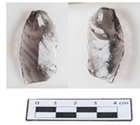 | 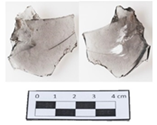 | 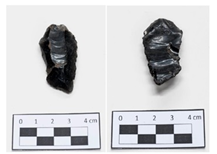 |
| (d) | (e) |
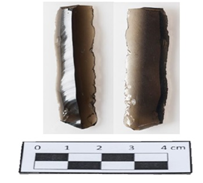 | 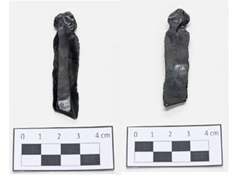 |
The obsidian samples from the first three sources were in all units studied, while the blades of Sierra de Pachuca were only found in units E, G, and K, which may indicate they were from household units.
The sources of raw materials used in Toxpan are located nearby, except for Sierra de Pachuca and El Paredón, which are located at distances of 299 km and 280 km, respectively. Green obsidian from Sierra de Pachuca is rare at the site and is only found as prismatic blades. A glassy gray flake is part of the current collection.
The Zaragoza-Oyameles source is located approximately 149 km from Toxpan and is associated with Cantona, a city thriving during the Mesoamerican Epi-Classic period (650-950 AD) (Cobean, 2002).
The obsidian from this source is almost entirely opaque black, but it can also appear in opaque and semi-glassy gray tones (Cruz Jiménez et al., 2002). The samples from Toxpan that came from the Zaragoza-Oyameles source are black and only two are opaque gray.
The Pico de Orizaba source is located ca. 60 km from Toxpan. The obsidian from this source is gray, opaque, glassy gray, and veined. Flakes and blades were recovered together, indicating manufacturing activity at the site.
The Guadalupe Victoria source is located 60 km from the archeological site, on the western slopes of the Pico Orizaba volcano, and is composed of pebbles found in ravines and streambeds. Although the source does not have large extraction zones or pre-Hispanic workshops, obsidian from Guadalupe Victoria was widely distributed in sites in southern Veracruz, Tabasco, and Oaxaca, primarily during the Formative Period (Cobean, 2002). The majority of artifacts analyzed from this source were 20 flakes and only 2 blades.
The location of the raw material sources and their involvement in established exchange networks during the occupation of Toxpan (100 BC-1450 AD) suggest that Toxpan interacted with three major trade routes. a) The Sierra de Las Navajas route controlled by Teotihuacan during the Classic period; b) the Cantona route that controlled the Zaragoza-Oyameles source (Jiménez-Reyesetal., 2016); and c) the Pico de Orizaba route, which supplied the cities of the Gulf Coast since the early Formative.
These trade routes reflect the connectivity of Toxpan with major centers of commerce and exchange during this period (Daneels & Miranda Flores, 1999).
The mentioned trade routes shared a widespread distribution, stretching from the Central Highlands to the Gulf Coast, crossing the elevations, canyons, and valleys of the Neo-volcanic Axis. Toxpan’s location in the Valley of Córdoba, situated between the rugged terrain of the Neo-volcanic Axis and the coastal plain, made it a key transit point along these routes, despite not having a political or administrative role within them.
During the Classic period (100 AD-650 AD), the intricate network of long-distance trade, which included the Sierra de las Navajas obsidian, was dominated by Teotihuacan through its enclave sites such as those in the Valle de Maltrata, Veracruz (Lira López, 2010; Molina-Vázquez et al., 2013). The limited presence of obsidian from this source suggests that Toxpan’s connection with these exchange networks was relatively superficial, and it primarily served as a transit point on the way to the Gulf Coast, rather than a hub of activity. This is in contrast to the Maltrata Valley sites, which have proven evidence of the influence of major Mesoamerican cities during the Classic period (Lira López, 2010).
All indications point to Toxpan having a close relationship with the Guadalupe Victoria and Pico de Orizaba sources located on the slopes of the volcano, with the first located west and the second located on the north face. The majority of the obsidian found at the site came from these deposits.
According to Daneels and Pastrana, (1988), Pico de Orizaba was the primary source of obsidian for sites in the lower basin of the Jamapa-Cotaxtla River, transported there by the water current/dragging of the Jamapa River, which rises on the north face of Pico de Orizaba and passes just 450 m from Toxpan when crossing the Córdoba valley. This proximity of the Jamapa River may explain why Pico de Orizaba was the main source of obsidian supply. As a result, Toxpan had some independence from the control of large cities along the Altiplano-Gulf coast routes and developed a local and regional lithic industry in conjunction with other sites in the Jamapa-Cotaxtla basin. The presence of flakes and micro-flakes (Ceja Acosta, 2009) associated with the carving process and the manufacture of bifacial blades and scrapers suggests that artifact production occurred at the site.
Conclusions
The obsidian analyzed and recovered at the San Francisco Toxpan archaeological site came from five sources with different chemical compositions, namely: Guadalupe Victoria (GP) in Puebla, Zaragoza-Oyameles (ZP) in Puebla, Pico de Orizaba (PO) in Veracruz, Sierra de Pachuca (SP) in Hidalgo, and Paredón (PP) in Puebla. Obsidian artifacts were more abundant from closer sources, such as GP, ZP, and PO.
The Jamapa River was the access route of the obsidian sources of the Pico de Orizaba volcano to Toxpan. Being close to the river giving access to the obsidian sources of the volcano (GP and PO), which were certainly the closest sources to the site.
Due to the geographical location and during the long period of occupation (Proto-classic (100 BC) to Mid Post-classic (1450 AD) of Toxpan, this site was part of the commercial exchange networks with established routes to move goods from one cultural area to another. Toxpan was a point in the trade route from the Central Highlands to the Gulf Coast used by great cities such Teotihuacan and Cantona. However, no evidence was found about the site being an enclave with political and/or administrative participation in these exchange networks, as observed in enclave sites. Probably the relationships of Toxpan were rather superficial, just as a passing point.
The autonomy of these significant cities likely facilitated Toxpan in strengthening its local and regional stone tool production industry by utilizing the Jamapa-Cotaxtla basin, with Pico de Orizaba serving as the primary source of obsidian supply.
The utilization of statistical techniques on concentration data played a pivotal role in identifying clusters, thus reinforcing the archaeological hypothesis regarding origin and trade connections.
Author contributions
X. González-Santos participated in the: Conceptualization, Methodology, Software, Writing – original draft, Writing – review and editing. M.D. Tenorio participated in the: Conceptualization, Methodology, Software, Writing – original draft, Writing – review and editing. M. Jiménez-Reyes participated in the: Conceptualization, Methodology, Software, Writing – original draft, Writing – review and editing. R.O. Molina-Vázquez participated in the: Conceptualization, Methodology, Software, Writing – original draft, Writing – review and editing.
Conflicts of interest
The authors declare no conflict of interest.
Acknowledgments
This research is a part of project number: RLA1019: Strengthening Capabilities for the Utilization of Nuclear and Radiation Technology Characterize, Conserve, and Preserve the Cultural Heritage, financed by IAEA. The authors thank the technical support of the nuclear reactor staff; and of J. Pioquinto, and A. Ortega as well.
References
Agha-Aligol, D., Lamehi-Rachti, M., Oliaiy, P., Shokouhi, F., Farahani, M. F., Moradi, M., & Jalali, F. F. (2015). Characterization of Iranian obsidian artifacts by PIXE and multivariate statistical analysis. Geoarchaeology, 30(3), 261–270. https://doi.org/10.1002/gea.21509
Álvarez Ríos, A. M.(1985). Reporte de la inspección efectuada en el Rancho Santa Margarita, Municipio de Córdoba, Ver. Xalapa, Veracruz.Academia Veracruzana de las Lenguas Indígenas.
Andrade Camacho, U. (2013). Altepetokayotl, Nombres geográficos de las regiones na huas del estado de Veracruz.Academia Veracruzana de las Lenguas Indígenas.
Bellot-Gurlet, L., Poupeau, G., Salomon, J., Calligaro, T., Moignard, B., Dran, J. C., Barrat, J.-A., & Pichon, L. (2005). Obsidian provenance studiesin archaeology: A comparison between PIXE, ICP-AES and ICP-MS.Nuclear Instruments and Methods in Physics Research Section B: Beam Interactions with Material sand Atoms, 240(1-2), 583–588https://doi.org/10.1016/j.nimb.2005.06.216
Ceja Acosta, A. (2009). Observaciones generales sobre la distribución de obsidiana en el postclásico en el sitio San Francisco Toxpan. Apuntes sobre algunas categorías analíticas y sus implicaciones. Proyecto de Salvamento Arqueológico San Francisco Toxpan, Córdoba, Veracruz. Informe final de temporada 2006-2007, 1–21.
Cobean, R. H. (2002). A World of Obsidian. The Mining and Trade of a Volcanic Glass in Ancient Mexico.Instituto Nacional de Antropología e Historia.
Cobean, R. H., Vogt, J. R., Glascock, M. D., &Stocker, T. L. (1991). High-Precision Trace-Element Characterization of Major Mesoamerican Obsidian Sources and Further Analyses of Artifacts from San Lorenzo Tenochtitlan, Mexico. Latin American Antiquity, 2(1), 69–91. https://doi.org/10.2307/971896
Cruz Jiménez, R. L., Tenorio, D., & Jiménez-Reyes, M.(2002). Caracterización por ANN de muestras de yacimientos de obsidiana del Golfo de México. Ciencia UANL, 5(3), 351–356.
Daneels, A., & Miranda Flores, F. A. (1999). La industria prehispánica de la obsidiana en la región de Orizaba. El valle de Orizaba: Textos de historia y antropología. InC. S. Sánchez & A. G. Márquez(Eds.), El valle de orizaba: Textos de historia y antropología(pp.27–60). Instituto de Investigaciones Antropologicas.
Daneels, A., & Pastrana, A.(1988). Aprovechamiento de la obsidiana del Pico de Orizaba: El caso de la cuenca baja del Jamapa-Cotaxtla. Arqueología, (4), 99–120.
Glascock, M. D. (2011). Comparison and Contrast Between XRF and NAA: Used for Characterization Of Obsidian Sources in Central Mexico. In M. S. Shackley(Ed.), X-Ray Fluorescence Spectrometry (XRF) in Geoarchaeology(pp. 161–192). Springer.https://doi.org/10.1007/978-1-4419-6886-9_8
Heredia Barrera, L. (1998). Relación de Sitios y Zonas Arqueológicos del Estado de Veracruz [Thesis, Universidad Veracruzana]. Universidad Veracruzana.
Jiménez-Reyes, M., Téllez Nieto, A. L., García-Cook, Á., & Tenorio, D. (2016). Obsidiana arqueológica de Cantona, Puebla: los diversos orígenes. Arqueología, 51, 133–152.
Jiménez-Reyes, M., Tenorio, D., Esparza-López, J. R., Cruz-Jiménez, R. L., Mandujano, C., & Elizalde. (2001).Neutron activation analysis of obsidians from quarries of the Central Quaternary Trans-Mexican Volcanic Axis. Journal of Radioanalyticaland Nuclear Chemistry, 250(3), 465–471.https://doi.org/10.1023/A:1017992920963
Lira López, Y. (2010). Tradición y cambio en las culturas prehispánicas del valle de Maltrata, Veracruz.Instituto de Investigaciones Antropológicas.
Melo Martínez, O. (2011). Toxpan: reto interdisciplinar para la arqueología Veracruzana. Universidad Veracruzana, México.
Miranda Flores, F. A. (1997). La transición del clásicoal postclásico en la región de Córdoba, Veracruz. In J.P. Laporte & H. Escobedo (Eds.), Investigaciones arqueológicas en Guatemala [Symposium]. 11th Simposio de investigaciones arqueológicas en Guatemala, Guatemala, México.
Miranda Flores, F. A., & Melo Martínez, O. (2009). Proyecto de Salvamento Arqueológico San Francisco Toxpan Córdoba,Veracruz, Informe final de temporada 2006-2007. Facultad de Antropología, Museo de Antropología y Centro INAH-Veracruz Mexico.
Molina-Vázquez, R. O., Jimenéz-Reyes, M., Lira-López, Y., & Tenorio, D. (2013). The origin of obsidian in the valley of Maltrata, Veracruz Mexico. Journal of Radioanalytical and Nuclear Chemistry, 295, 915–922.https://doi.org/10.1007/s10967-012-2307-8
Shaw, B., Irwin, G., Pengilley, A., & Kelloway, S. (2021). Village-specific Kula partnerships revealed by obsidian sourcing on Tubetube Island, Papua New Guinea. Archaeology in Oceania, 56(1), 32–44.
